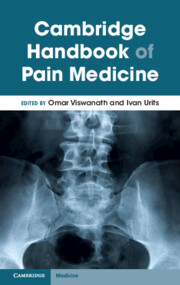Book contents
- Cambridge Handbook of Pain Medicine
- Cambridge Handbook of Pain Medicine
- Copyright page
- Contents
- Contributors
- Pain Handbook Introduction
- Part I Introduction to Pain: Pain Signaling Pathways
- Part II Common Categories of Pharmacologic Medications to Treat Chronic Pain
- Part III Chronic Pain Conditions Head and Neck
- Part IV Spine
- Part V Extremities
- Part VI Misc
- Chapter 26 Post-herpetic Neuralgia (PHN)
- Chapter 27 Complex Regional Pain Syndrome (CRPS)
- Chapter 28 Sickle Cell Disease
- Chapter 29 Breast Pain
- Chapter 30 Post-thoracotomy Pain
- Chapter 31 Multiple Sclerosis Pain
- Chapter 32 Cerebral Palsy
- Chapter 33 Myofascial Pain Syndrome
- Chapter 34 Post-stroke Pain
- Chapter 35 Chronic Abdominal Pain
- Chapter 36 Chronic Pelvic Pain
- Chapter 37 Postsurgical Nerve Entrapment
- Chapter 38 Cancer Pain
- Part VII Adjunctive Therapy
- Index
- References
Chapter 33 - Myofascial Pain Syndrome
from Part VI - Misc
Published online by Cambridge University Press: 01 December 2023
- Cambridge Handbook of Pain Medicine
- Cambridge Handbook of Pain Medicine
- Copyright page
- Contents
- Contributors
- Pain Handbook Introduction
- Part I Introduction to Pain: Pain Signaling Pathways
- Part II Common Categories of Pharmacologic Medications to Treat Chronic Pain
- Part III Chronic Pain Conditions Head and Neck
- Part IV Spine
- Part V Extremities
- Part VI Misc
- Chapter 26 Post-herpetic Neuralgia (PHN)
- Chapter 27 Complex Regional Pain Syndrome (CRPS)
- Chapter 28 Sickle Cell Disease
- Chapter 29 Breast Pain
- Chapter 30 Post-thoracotomy Pain
- Chapter 31 Multiple Sclerosis Pain
- Chapter 32 Cerebral Palsy
- Chapter 33 Myofascial Pain Syndrome
- Chapter 34 Post-stroke Pain
- Chapter 35 Chronic Abdominal Pain
- Chapter 36 Chronic Pelvic Pain
- Chapter 37 Postsurgical Nerve Entrapment
- Chapter 38 Cancer Pain
- Part VII Adjunctive Therapy
- Index
- References
Summary
Myofascial pain syndrome (MPS) is characterized by localized, taut regions comprising of skeletal muscle and fascia, termed trigger points and is an increasingly prevalent complaint. Pharmacologic interventions with evidence to support their use in MPS include muscle relaxants such as benzodiazepines, tizanidine, and cyclobenzaprine; TCAs; topical agents such as diclofenac gel and lidocaine patches; and injection therapy of botulinum toxin or lidocaine. MPS is poorly understood and remains a challenging condition to treat. Nonpharmacologic treatment modalities such as acupuncture, massage, transcutaneous electrical stimulation, and interferential current therapy may offer relief to some patients with MPS. Additional studies are warranted to get a better understanding of managing myofascial pain.
- Type
- Chapter
- Information
- Cambridge Handbook of Pain Medicine , pp. 261 - 278Publisher: Cambridge University PressPrint publication year: 2023

